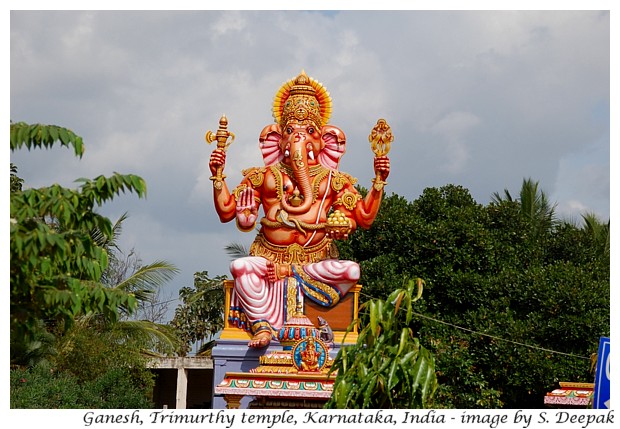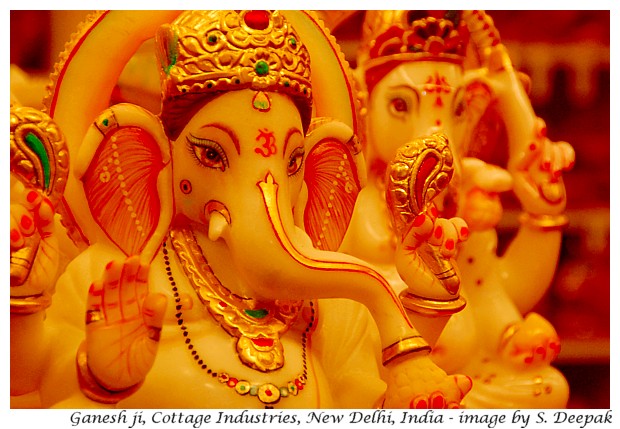The Book: Ginger and Ganesh
Nani Power’s quirky book “Ginger and Ganesh – An Adventure in Indian Cooking, Culture and Love” (2019, Counterpoint, Berkeley) is a personal memoir of her love story with an Indian student and an exploration of Indian homes in North Virginia (USA) in search of traditional Indian recipes.
The book is dedicated to the Ganesh, “O elephant-faced God, Ganesha, you are served by the attendants of Shiva and you eat forest apples and blackberries. You are Uma’s son, the destroyer of sorrows. I bow to the lotus feet of the remover of obstacles”.
In the book, she explains her fascination with the figure of Ganesh: “On this path I met Sri Ganesh. You may be familiar with him: he is the ever-popular elephant-headed deity, accompanied by a tiny mouse. He has a large jovial belly, and holds a conch shell. I’m not sure why he in particular ignited my passion for this culture and beyond, but perhaps it was the fact that his statue was present the first time I tasted the incendiary potions of India I came to love. Or maybe, the wisdom and calm that he emanates soothed my world-weary soul, and he seemed to be a constant reminder—at the doorway of most houses, or in their altars—that I was on a spiritual path as well as physical.”
In the book, stories of encounters with Indian families alternate with vegetarian recipes and brief reflections about Ganesh ji, after she had placed a simple advertisement in the Craiglist about wishing to learn traditional Indian recipes. The book chronicles her experiences over a period of one year, summarised in the following words:
Almost imperceptibly, the culture of this rich and varied country slithered into my life like a sinuous cobra, combining the modern ways of the United States with the Technicolor of India, while I ate some damn good food. I wanted to understand the Indian culture and people; and what seemed so enchanting was that I was constantly being surprised and challenged by how complex—and contradictory—it can be. While at one time thousands of years old, in another time it seems jauntily modern, yet where this occurs bewilders me. I have learned to keep an open mind. Now, after this year of cooking real Indian food, I realize that the only real way to learn to cook is through the senses and heart. It turns out that it is the only real way to live and to love, as well …This simple year long cooking lesson—innocently started as a little two-line ad on Craigslist because I was frustrated with my lame attempts at Palak Paneer—taught me a lot more than how to make a killer spinach and cheese curry. It smashed open my heart, in so many ways. The kindness of the women, the beauty of the culture, the explosion of flavors, and, curiously, the very physical act of cooking led me to examine what is beyond all this: the spiritual realm.
Ganesh, the People’s God
The word Ganesh is made of Gan (people) and Ish (God) and he is one of the most popular deities in Hinduism.
Hinduism has different and sometimes contradictory ways of defining and understanding God. There are Hindu hymns which talk of God as a formless, beginning-less, ending-less, eternal consciousness which pervades all atoms and molecules. God is also present in each of us, humans, animals and plants, as part of our consciousness, as part of our soul. Then there are Hindu hymns which identify God through human and animal avatars – the pantheon of 33 million major and minor Gods.
Each Hindu deity is known by different names in different parts of India and Ganesh ji is no exception. Some of his other names are – Ganapati (people’s leader), Adidev (ancient God), Gajanan (elephant face), Gaurinandan (son of Gauri), Lambodara (big belly), Prathameesh (first God) and Vidyadhar (one who holds knowledge).
Mythology About Ganesh
The Hindu Gods can be seen as statues of deities, some of them in strange shapes and forms linked with mythologies. They can also be seen as symbols of different aspects of the human reality with deeper meanings.
The mythological stories about Ganesh ji, present him as the creation of Parvati (the daughter of the Himalaya mountain), the consort of Shiva. While Shiva is away on a long journey, Parvati creates Ganesh out of her own body. When Shiva comes back, Ganesha is a child, who does not recognise him. Since his mother is taking a bath, he blocks Shiva’s path, refusing to let him enter their home. An angry Shiva cuts his head. When Parvati finds this out, she is grief-stricken so, Shiva sends his men to look for a substitute head, and those men bring the head of an elephant. Thus, Ganesh ends up with an elephant's head.
Metaphorical Understandings of Ganesh
I am sure that Freud would have a theory about meanings and significance of Ganesh linking him with sex or sexuality. However, I think that Ganesha is a metaphorical representation of human brain and the different functions of mind in Hinduism.The story of the replacement of Ganesh’s head with that of an elephant can be seen as a metaphor for human evolution, the arrival of Homo sapiens, those with the memory and intelligence. Elephants are known for their memory and their intelligence, and thus Ganesh can be seen as a representation of the human brain and therefore, of the emotions and instincts, as well as of the rational mind.
Different names of Ganesh point towards the different functions of the brain. As Vighnakarta and Vinayak, he is the one who creates obstacles; and as Avighna, Siddhivinayak and Vighnaharan, he is also the one who overcomes obstacles. As Vidyadhar, he holds all the knowledge. As Yogadeep, he is the one who does yoga and meditation. As Uddanda, he is the wild one, the one difficult to control. As Sarvasiddhanta he controls different skills. As Harsha and Pramod, he signifies happiness. As Kaveesha, he inspires our poetry and creativity. As Ekadrishta, he controls our mind’s focus and attention.
Thus, for me Ganesh is the guide to the path of meditation and reflection for controlling the mind and the senses, for focusing our attention and building our strengths. He reminds us that we create our own obstacles and teaches us to empower ourselves for overcoming those obstacles.
Conclusions
I like the figure of Ganesh ji because I think that the combination of his human and animal forms, is an important reminder to humanity to respect the earth, the environment and the nature. His vehicle, the tiny mouse, is another reminder that every life on our planet, even that of the smallest creature, is important for our biodiversity and for the future of humanity.
Hinduism has different human-animal mixed figures including those of Hanuman and Narsimha. It also has some animal and bird forms as deities, such as those of Varaha and Garuda. All the different Gods and Goddesses of Hinduism are linked to an animal and to a plant. Thus, every life form and every component of nature is seen as sacred. As we move recklessly towards destruction of nature and of biodiversity, it reminds us to be responsible for the way we use technology and safeguard the nature for the future of humanity.
Finally I also like that our Gods can have deeper metaphorical meanings, like the significance of Ganesh as a representation of Brain and mind. This way of understanding religion is more complex and non-linear, it does not have the God as a saviour or as someone who punishes you for your sins or tells you what to do or not do, instead, it is guide to the reality and complexity of life.
*****
*****
#ganeshji #hinduism #religion #philisophy #nanipower #bookreview #recipes #indiancooking















































